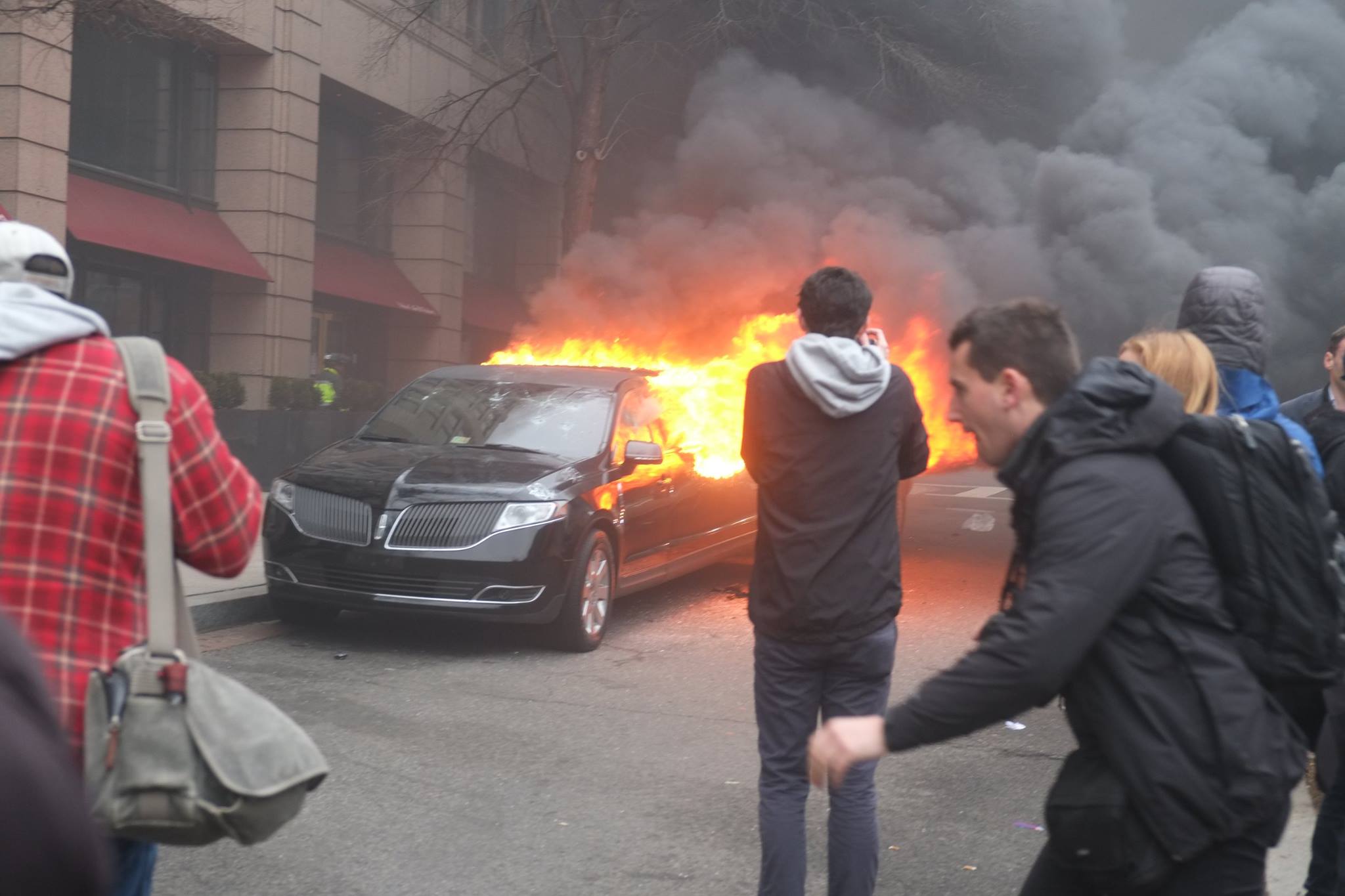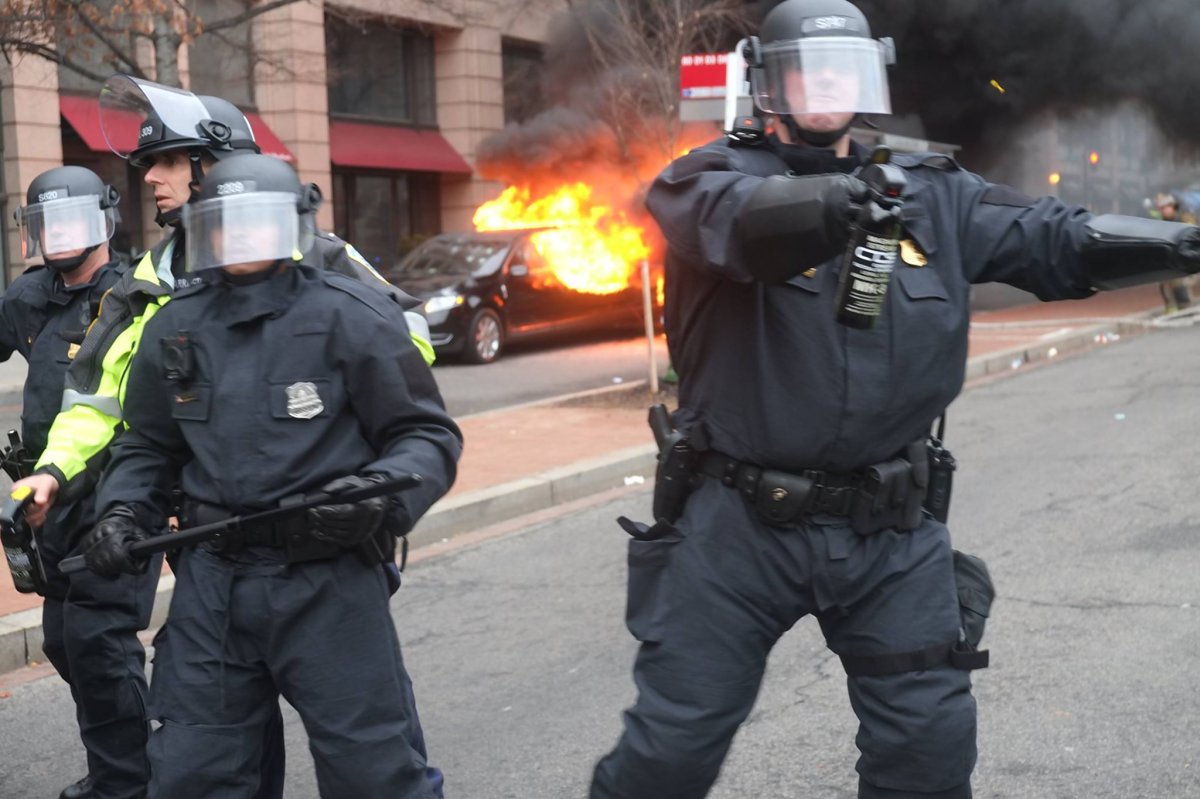BY BILL WEINBERG | ‘I was put into a kettle when Obama was still president and I was released when Trump was president. I literally went through a militarized police funnel to start the new administration.”
So says Matt Hopard, a Brooklyn-based social media activist and veteran of Occupy Wall Street who was arrested in downtown Washington, D.C., on the morning of Inauguration Day. Interviewed back in New York after his release, he was quick to add: “Mind you, I was there as a journalist and documentarian.”
Like most of the estimated 230 protesters arrested on Inauguration Day, Hopard faces felony rioting charges. Also like many others, his only crime was being in proximity of protesters who attempted to disrupt police checkpoints in the blocks east of McPherson Square, within the security cordon for the parade route. Some of the more ambitious protesters notoriously smashed a Starbucks window and even set a limousine on fire.
Hopard and the others busted with him at 12th and L Sts. were constrained in a “kettle” — an improvised pen of police barricades — for more than six hours. Penned in before noon, they weren’t hauled off to jail until around 6 p.m. The hours passed in the cold and intermittent rain, with no access to water or toilet facilities. They were released from jail the following evening.

This reporter wasn’t around for these shenanigans. After touching in with the “Disrupt J20” gathering at McPherson, I headed down to the National Mall to try to witness the inauguration — and see if anyone was expressing dissent on the scene.
It was an eerie atmosphere there in the middle of the mall at the moment that the feared and historic transition took place. As a witness, I can provide my own testimony on the numbers controversy that has ensued since the inauguration, with Trump claiming he had the biggest crowd of any president ever — a claim assailed by the media as frankly bizarre.
Ahead of me, toward the Washington Monument, a small trickle had made its way through the security checkpoint and was just beginning to fill in the expanse of grass. There, a big screen projected the important goings-on at the Capitol steps a mile and a half beyond.
With Trump still speaking, I drifted back toward Constitution Ave., which borders the mall on the north. Trump supporters — overwhelmingly although not exclusively white, ranging from clean-cut frat boys to shaggy political pilgrims from backwoods Appalachia — mixed uneasily with a few clusters of protesters.
A young black woman held a sign reading: “Racism is the disease; love, understanding and compassion are the answer.” The group around her chanted “Sexist, racist, anti-gay; Donald Trump, go away!” A passing Trump supporter taunted the group: “You lost, losers!” One shot back: “Trump is racist!” The heckler retorted, with no apparent logic: “You are, too!”
But he moved on, and I witnessed no violence.

I started to make my way back to the McPherson Square area, where the bulk of the protesters were. Winding through the streets (the most direct route was now cut off by the police, with the parade imminent), the crowd was about evenly divided between Trump fans and protesters. My efforts to engage the Trump supporters met with little response.
“He’s gonna be great,” said one middle-aged, middle-class type in an old-school suit, walking with his wife. “He’s gonna concentrate on real things, instead of wasting time and money on silly things like Obama’s been doing.” When I asked him what sort of “real” things he meant, he ventured: “Law enforcement.”
We arrived at Farragut Square, established as a sort of staging ground by the protesters, with big tents and displays set up. The surrounding streets were filled with noisy, spirited anti-Trump protesters, some beating on drums and most holding handmade signs.
I marched with them toward McPherson — beyond which, the police were blocking access, and hundreds of arrestees waited endlessly in “kettles.” Just before the police lines, some hotheads had set a garbage can on fire, and the air was filled with acrid smoke.
A young Asian woman had a hand-scrawled message with a wistful but determined tone: “YES WE COULD, YES WE DID, YES WE WILL.” Her name was Selena (she declined to give a surname), and she works with a juvenile justice advocacy group in Baltimore. I asked, What will we do? “Keep protesting, keep fighting,” she said.
Two young white guys held aloft a big banner with a reproduction of a panel from a 1940s comic book showing Captain America slugging Hitler and sending him flying. The caption: “Fighting Nazis is an American tradition! Stop the ‘alt-right’!”
One of the two was Gabe Lezra, a lawyer from New York City. When asked about his banner, he replied, “The alt-right represents a fascistic current in American politics, reflected in waves of hate crimes. One of the most important cultural battles going on now is against the emergence of a radical European-style right-wing politics in this country.”
A sandy-haired man held a particularly provocative sign — for this crowd. It had the faces of Ralph Nader and Jill Stein — the Green Party presidential candidates in 2000 and 2016, respectively — in red circles with slashes across them. It read: “When is the delusional ‘Green Party’ going to stop electing Republicans?”
The sign holder was Sean McCrohon, a D.C.-area independent researcher.
“Hillary was not perfect, obviously,” he said. “But we had a binary choice and a vote for anyone else was a vote for Donald Trump. There’s no sense in America in creating minor parties. You have to build coalitions. It’s slow and frustrating. It’s important to challenge young people who think there’s no difference between the Democrats and Republicans.”
And now?
“God knows we’re facing the worst president since the Civil War — since Jefferson Davis,” he said. “He has the mind of a 7-year-old, and he has the ability to destroy the world. We have to do everything we can to resist. I’ve never felt so despairing about the future of the country.”
He also recommended, “We have to force the Democrats to stop him from acting on his agenda, to filibuster, to do whatever it takes.”
Staceyann Chin, a Jamaica-born Brooklyn-based poet, story-teller and L.G.B.T. activist, was taking in the scene as I was. I asked her thoughts on the challenges ahead. Staying in town for the massive Women’s March the following day, she emphasized the urgency of moving beyond single-issue politics.
“We’re going to have to be multi-sectorial and multi-platform,” she said. “Everything we do has got to make the connections. We have to talk to each other like never before. We have to find out what ‘together’ looks like. The system is predicated on division. But we’re in a new soup.”
Almost as an admonition to herself, she added, “I have to remind myself why tomorrow is important, and why the next four years of resistance is important — mandated, in fact.”

















